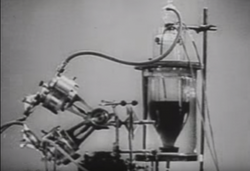No edit summary |
No edit summary Tag: Source edit |
||
| Line 1: | Line 1: | ||
{{Infobox/Gadget |
{{Infobox/Gadget |
||
|titleName = Sergei Brukhonenko's Autojektor |
|titleName = Sergei Brukhonenko's Autojektor |
||
| − | |image = |
+ | |image = File: Revival of organisms.png |
|caption = |
|caption = |
||
|origin = Sergei Brukhonenko |
|origin = Sergei Brukhonenko |
||
| Line 20: | Line 20: | ||
Touching the skin will cause the subject’s heart and lungs to start working at peak capacity, providing they still have either. The energy is enough to make the brain and sensory organs aware of the surroundings, although not calm. This unnatural restart requires energy, and given there will be very little food calories left to convert, the process burns up all non-essential organs and muscles on a cellular level until there is no more energy available. |
Touching the skin will cause the subject’s heart and lungs to start working at peak capacity, providing they still have either. The energy is enough to make the brain and sensory organs aware of the surroundings, although not calm. This unnatural restart requires energy, and given there will be very little food calories left to convert, the process burns up all non-essential organs and muscles on a cellular level until there is no more energy available. |
||
[[Category:Gadget]] |
[[Category:Gadget]] |
||
| − | [[Category: |
+ | [[Category:Scalec]] |
| − | [[Category:Image Missing]] |
||
Latest revision as of 17:12, 27 November 2020
| Sergei Brukhonenko's Autojektor | |
|---|---|

| |
|
Origin |
Sergei Brukhonenko |
|
Type |
Life Support Machine |
|
Function |
Restarts heartbeat and breathing in recently deceased |
|
Location |
|
|
Collected by |
Warehouse 13 |
|
Retrieval |
April 15, 1994 |
| [Source] | |
Origin
Sergei Brukhonenko was a Soviet scientist who performed open heart procedures and experimental surgery techniques. He was famous for creating the medical apparatus he dubbed the autojektor, a precursor to the modern day heart and lung bypass machine used in surgery. Testing it upon dogs, his experiments achieved mixed results, although they were well documented and earned him the Lenin Prize. He was also known for experimenting on the resilience of life support, decapitating animals and keeping them alive for hours at a time.
Effects
Touching the skin will cause the subject’s heart and lungs to start working at peak capacity, providing they still have either. The energy is enough to make the brain and sensory organs aware of the surroundings, although not calm. This unnatural restart requires energy, and given there will be very little food calories left to convert, the process burns up all non-essential organs and muscles on a cellular level until there is no more energy available.
